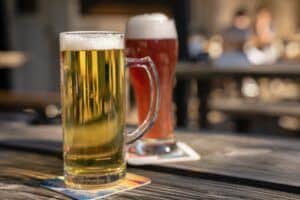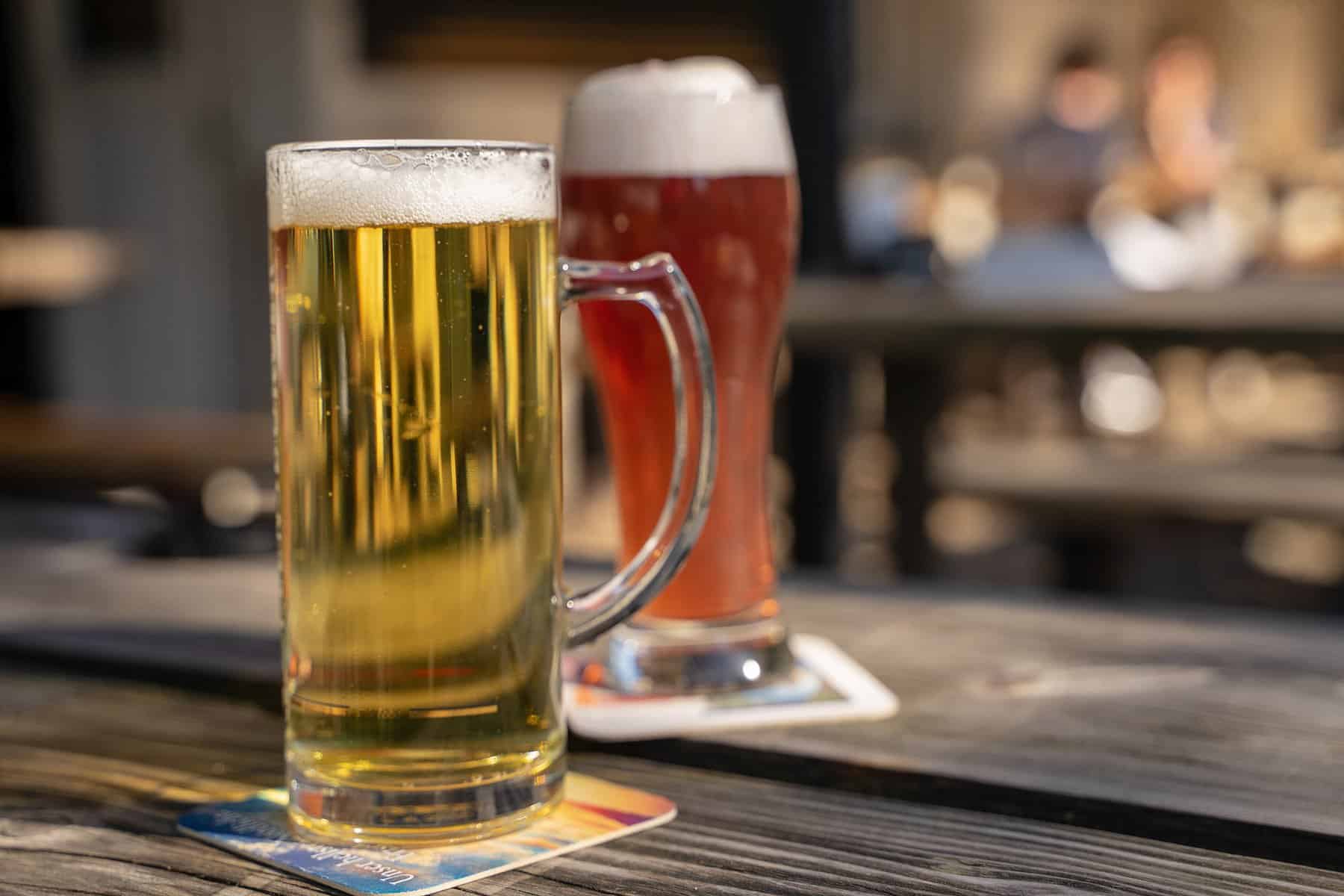In this day and age, most people know what a beer is. But the majority of people have no idea what the different types of beers are. If you ask the average beer drinker what is the difference between ale and lager, they are going to give you a blank stare or bumble through some way off-the-base explanation.
Now to be fair it is typically only major beer lovers or home brewers like us know that know the differences between the types and styles of

But to those of us who do know the difference lumping them all into one category of beer is a crime. As each style has its own interesting story and history of how it came into existence as well they all use their own unique ingredients, tastes and modes of preparation that are in some cases vastly different to the other styles.
If you are new to home brewing take the time to read and understand this post. Within it you are going to learn some interesting insights into the two most common styles of beer.
Yup Ales and Lagers.
By reading this post and educating yourself you are going to be able to dazzle all of your beer-drinking friends at the next party with your newfound beer knowledge. You will become the beer guru and your friends will adore you! Well maybe that is taking things a bit far… but hopefully you will at least enjoy this post and learn a few things.
Let’s Start with Ales
Ales have been the go-to beer around the world for many many years. Throughout history, you can read accounts of ales being brewed and served. European history is especially filled with these accounts.
Not surprisingly the ingredients that were used to brew this style of beer back then and now have not changed much at all. In ancient times it was made with the same thing it is now, water, grains, and hops along with yeast. Sometimes other ingredients like fruit were added to it to give it flavor. That is also true today.
Beer was drunk by pretty much everyone in the “old” days. Why because it was safe. Far safer than the water to drink. And it was also viewed as being a nutritious drink.
You have probably heard the story of Arthur Guinness the founder of Guinness in Ireland. I have no idea if the story is true but apparently, he claimed God gave him the recipe and it was viewed as having helped people with nutrition back in the potato famine.
The production of Ale was also very much of a business venture back in the middle ages. But it might surprise some of you that the main producers of it were women; called Alewives. They would make it out of their home for themselves and their families and also used the production of it as a secondary income by selling it locally.
As stated Ales were an important source of vitamins and minerals for medieval people. It was actually considered 1 of the 3 primary sources of grains, along with bread and potatoes.
It should be noted that not all ales were created the same. So do not get the wrong impression here that in the old day’s people were walking around drunk all day long.
Strong ales were available but they were saved for occasions just like now, parties and festivities, etc.
What the people would have drank on a regular basis was a mild beer. This mild beverage would have had significantly less alcohol in it and the purpose of the alcohol within it would have been to act as a preservative.
Everyone would have drunk it including children and the reasons again were because it was safer than water and had nutritious qualities to it.
So there you have it a brief history of Ale. Pretty cool stuff when you look back on how it came to be.
But enough of the history lesson, let’s jump into a quick overview of how it is made…
Brewing an Ale
Brewing an ale and a lager is actually very similar, the difference is when you get into fermenting and lagering. We will talk more about that in the Lager section of this article.
The basics of an ale recipe will call for water, barley, hops and yeast. Of course there are optional items you can add to the recipe to modify its taste and texture, etc.
You can check out some of my favorite ale recipes here (LINK)
When it comes to equipment you will need:
- A kettle to heat water in
- A container to mash in. Mashing is basically soaking the grains in warm water to get the sugars and starches out of them. Very much like making tea, where you put the tea bag in the water to get the goodness out of the bag.
- A kettle to boil in.
Note: you can get a system that combines all of these 3 vessels into one and that is how I recommend you proceed, you can check that out here: BIAB Brewing
- You then need a fermenter to ferment in. A plastic fermenting bucket will work just fine.
- Thermometer
- A hydrometer to check the gravity to determine when the beer has stopped fermenting and to calculate its ABV (alcohol by volume).
- Beer bottles or kegs.
Brewing the Ale
Making the actual beer is not quite as complicated as you would think.
Basically, you are first creating what is referred to as the wort. The wort is the sugary solution that you then ferment with yeast to turn into beer.
You again make the wort by soaking the grains in hot water and then transferring the wort to the boil kettle to boil for 60 – 90 minutes.
It is during the boil that the majority of the hops are added to the wort. Some hops are for bittering, others for aroma and taste.
After the boil is finished the wort is cooled and then transferred to the fermenting vessel, where the yeast is added (pitched).
Fermentation typically takes about 5- 10 days. You can use what is referred to as a hydrometer to determine when fermentation is completed.
Once the homebrew is done fermenting it is then time to bottle or keg it.
Let’s now look into lagers…
A Brief History of Lagers
Believe it or not, lagers are the most well-known and popular beer around the world. Most of the larger commercial breweries’ beers are lagers. Think Budweiser, Miller lite, Stella, etc.
Lagers came into existence in the north of Europe between Austria and Germany.
The big difference between a lager and an ale is actually in the yeast that is used. Lager yeast ferments slower and at colder temperatures and on the bottom of the fermenter, whereas ales ferment faster, at warmer temperatures and at the top of the fermenter.
Back in the Middle Ages as you can imagine they did not have the means to control fermentation temperatures like we do today. As such yeasts that were able to withstand and even excel during cold fermentation were a great asset to beer-making during the cold months of the year.
Process of Making Lager
In regards to brewing the actual lager, it is the exact same equipment and process as with ales.
You can check out this post to learn the exact steps and equipment you need.
The difference is the yeast. You will want to use a larger yeast. There are many available on the market. Try one yeast and then another one and so on and so forth until you find the one you like the best.
As far as recipes go, you can in fact use any ale recipe if you like. There are also many lager recipes that can be easily found on the internet. If you use an ale recipe I would recommend a lighter recipe like a Blonde ale.
Fermenting is where things get more involved when making a lager as opposed to an ale. Fermenting will take at least 3 weeks. You will want to ferment between 8 – 12 degrees C or 46 – 53 degrees F.
After 3 weeks you now have a lager home brew. But I wish I could tell you that you could bottle it and be done, however, there is still more involved.
You now need to lager the beer.
This I accomplished by dropping the temperature to 1 – 4 degrees C or 33 – 39 degrees F, just above freezing. Lower the temperature slowly over a few days so as not to shock the yeast.
Once the temperature has been reached you leave it to sit for another 3 weeks. By doing so all of the solids are going to drop out of suspension and you are going to have a very clear and crisp lager.
Ales Verses Lagers
As you can see ales are easier and quicker to make and that is one of the main reasons why most brewers brew ales versus lagers. Having the ability to ferment cold is costly as you need the right sort of chamber to house the beer as it ferments at those lower temperatures, which can be expensive and takes up more space in your home.
Ales are simply more flexible. You have more freedom to experiment with them and add different ingredients to them. The majority of beers that you probably know are ales. This would include blondes, goldens, Kolsch, pale ales, IPA’s, NEIPA’s, Ambers, Reds, Browns, Stouts, Porters, etc.
If you do decide to use an ale recipe to brew a lager expect a completely different-tasting beer than if you brewed it as an ale.
Ales overall have a more of a malty taste to them and can also be quite bitter as well as having fruity aromas and tastes depending on the ingredients used; whereas lagers have more of a crisp, clean and smooth taste to them.
To Sum it Up
Both of these styles of beer are very popular in our modern times. It seems that large commercial breweries focus more on lagers whereas home brewers and smaller commercial craft breweries focus more on making ales.
One of the beautiful things about being a home brewer is that you can experiment. Try adding different ingredients to both your ale and lagers.
I trust you enjoyed this brief overview of what is the difference between ale and lager. In the end, they are both great beers and it simply comes down to what you prefer to brew and of course drink.
If you have any questions do not hesitate to ask me in the comment section below. I will be sure to do what I can to help.
P.S. If you brew your own beer or are considering doing so be sure to pick up your gift or Big Robb’s top 5 favorite beer recipes from his brewpub. Details are on the side of the blog or at the bottom if you are on your phone. Cheers!

